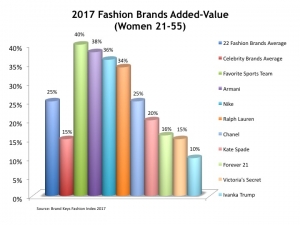 OK, let’s say you have a 100% cotton dress shirt. It was probably made in China or Indonesia or one of the 5 factories turning out virtually everything these days. As is, it’s going to sell at retail for $18 (OK, $18.99, but for the purposes of this exercise, let’s keep the math simple).
OK, let’s say you have a 100% cotton dress shirt. It was probably made in China or Indonesia or one of the 5 factories turning out virtually everything these days. As is, it’s going to sell at retail for $18 (OK, $18.99, but for the purposes of this exercise, let’s keep the math simple).
If, for example, you were to affix a store-brand label to it, like Macy’s “Alfani,” the perceived value of the shirt goes up by about 9%, so the shirt can now be sold for $20. So as a retailer you just made an extra $2 that the customer was actually more than willing to pay, because the brand added value to what was just a 100% cotton dress shirt.
That same shirt with a Ralph Lauren label could sell for $25 because the brand brings added-value of 34% to the product. And because brand added-value is mostly emotional, a customer’s favorite sports team adds 40%, which is why they can sell those sports jerseys for $50. And so it goes. Nike adds 36%, while Forever 21 only adds 16%, or what works out to a difference of $5. For precisely the same shirt. Just a different label.
According to our 2017 Fashion Brand Index, the average added-value across 22 brands was +25%. And sure, the high-fashion brands can start at a higher base price than store-brands for precisely the same shirt, but our analysis provides a reasonable emotional value brand-to-brand comparison.
This year – for all the obvious reasons – we added “Ivanka Trump” (a brand that was never large enough to make previous lists, which are based on unaided consumer mentions) to our assessments. The Ivanka label added value of 10%, only 1% more than an established store brand.
Being able to assess a brand’s ability to add value is critical, especially if the brand is planning on licensing everything it can put its name on. So maybe the Nordstrom decision to drop the Ivanka Trump brand was exactly what they said. Just a good business decision.
And like Ralph Lauren said about his brand “I don’t design clothes. I design dreams.”
Find out more about what makes customer loyalty happen and how Brand Keys metrics is able to predict future consumer behavior: brandkeys.com. Visit our YouTube channel to learn more about Brand Keys methodology, applications and case studies.
Share this: